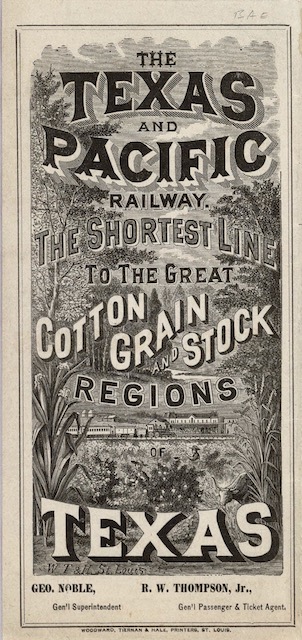Like most railroads with “Pacific” in their name, the goal of the Texas & Pacific was to build to the Pacific Ocean, in this case, San Diego. By the time this time table was issued, it had only built from Texarkana (where it met the Iron Mountain Route) some 253 miles to Fort Worth. Eventually, it made it another 500 miles to a town called Sierra Blanca, where it met and exchanged traffic with the Southern Pacific. T&P was independent in 1878, but Jay Gould gained control of it the very next year and eventually it was merged into the Missouri Pacific.
 Click image to download a 8.3-MB PDF of this timetable, which is from the David Rumsey map collection.
Click image to download a 8.3-MB PDF of this timetable, which is from the David Rumsey map collection.
Like the International & Great Northern, T&P only had one train a day over its main line, but used three panels of this brochure to show the timetable so it could show connections to Chicago, Cincinnati, and Chattanooga. A fourth panel shows a second train on a branch line from Texarkana to Sherman, Texas. Also like the I&GN timetable, this one only shows the schedule for westbound trains; presumably another timetable was printed for eastbound trains.
The one-train-a-day to Fort Worth was rather inconveniently timed, arriving in Fort Worth at ten minutes after midnight. Since it departed Texarkana at 9:30 am, it could have saved people some sleep by leaving an hour or so earlier. However, the connecting Iron Mountain train from St. Louis (which connected with trains from Chicago) is shown to arrive in Texarkana at 9 am, so T&P might not have had much choice about the departure time.
Neither of the trains have a name. Unlike the previous timetables, they are not even dignified with the word “express” on the schedules.
Most of the rest of the panels on the non-map side of the brochure are devoted to lauding Texas as a place to settle and farm. “In 1887 its population will exceed 4 millions,” it predicted. In fact, it reached 4 million only sometime after 1910. Today, of course, it is the second-most heavily populated state in the country, but it wasn’t until air conditioning was invented that its population really grew.
